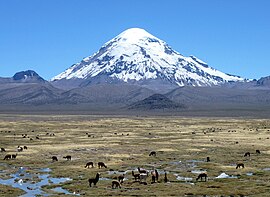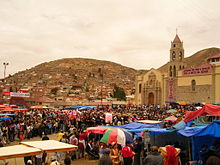Oruro Department
Oruro
| |
|---|---|
 | |
 Location within Bolivia | |
| Country | |
| Capital | Oruro |
| Provinces | 16 |
| Government | |
| • Body | Departmental Legislative Assembly of Oruro |
| • Governor | Johnny Franklin Vedia (MAS-IPSP) |
| Area | |
• Total | 53,588 km2 (20,690 sq mi) |
| Population (2024 census) | |
• Total | 570,194 |
| • Density | 11/km2 (28/sq mi) |
| Time zone | UTC-4 (BOT) |
| HDI (2019) | 0.727[1] high · 4th of 9 |
| Languages | Spanish, Quechua, Aymara |
| GDP (2023) | constant Dollar of 2015[2] |
| - Total | US$ 1.6 billion Int$ 3.7 billion (PPP) |
| - Per capita | US$ 2,700 Int$ 6,400 (PPP) |
| Website | www |
Oruro (Spanish pronunciation: [oˈɾuɾo]; Quechua: Uru Uru; Aymara: Ururu) is a department of Bolivia, with an area of 53,588 km2 (20,690 sq mi). Its capital is the city of Oruro. According to the 2012 census, the Oruro department had a population of 494,178.
Provinces of Oruro
[edit]The department is divided into 16 provinces which are further subdivided into municipalities and cantons.
| Province | Map # | Area (km2) | Population (2012 census) |
Capital |  |
|---|---|---|---|---|---|
| Carangas | 10 | 5,472 | 11,041 | Corque | |
| Cercado | 2 | 5,766 | 309,277 | Oruro | |
| Eduardo Avaroa | 5 | 4,015 | 33,248 | Challapata | |
| Ladislao Cabrera | 12 | 8,818 | 14,678 | Salinas de Garci Mendoza | |
| Litoral | 13 | 2,894 | 10,409 | Huachacalla | |
| Nor Carangas | 8 | 870 | 5,502 | Huayllamarca | |
| Pantaleón Dalence | 3 | 1,210 | 29,497 | Huanuni | |
| Poopó | 4 | 3,061 | 16,775 | Poopó | |
| Puerto de Mejillones | 16 | 785 | 2,076 | La Rivera | |
| Sabaya | 15 | 5,885 | 10,924 | Sabaya | |
| Sajama | 14 | 5,790 | 9,390 | Curahuara de Carangas | |
| San Pedro de Totora | 9 | 1,487 | 5,531 | Totora | |
| Saucarí | 7 | 1,671 | 10,149 | Toledo | |
| Sebastian Pagador | 6 | 1,972 | 13,153 | Santiago de Huari | |
| Sud Carangas | 11 | 3,536 | 7,231 | Santiago de Andamarca | |
| Tomás Barrón | 1 | 356 | 5,267 | Eucaliptus |
Note: Eduardo Abaroa Province (#5) is both north of and south of Sebastián Pagador Province (#6).
Government
[edit]Executive offices
[edit]The chief executive officer of Bolivian departments (since May 2010) is the governor; until then, the office was called the prefect, and until 2006 the prefect was appointed by the president of Bolivia. The current governor, Johnny Franklin Vedia Rodríguez of the Movement for Socialism – Political Instrument for the Sovereignty of the Peoples, was elected on 7 March 2021.[3][4]
| Took office | Office expired | Prefect/Governor | Party | Notes |
|---|---|---|---|---|
| 22 Jan 2006 | 30 May 2010 | Alberto Luís Aguilar Calle | MAS-IPSP | First elected prefect. Elected in Bolivian general election, December 2005 |
| 30 May 2010 | 31 May 2015 | Santos Javier Tito Véliz | MAS-IPSP | Elected in the first round of the regional election on 4 April 2010; first governor. |
| 31 May 2015 | 19 Nov 2019 | Víctor Hugo Vásquez Mamani | MAS-IPSP | Elected in the first round of the regional election on 29 March 2015. |
| 19 Nov 2019 | 31 May 2020 | Zenón Pizarro Garisto (interim) | MAS-IPSP | |
| 31 May 2020 | 3 May 2021 | Edson Milton Oczachoque Gerónimo (interim) | MAS-IPSP | |
| 3 May 2021 | Johnny Franklin Vedia Rodríguez | MAS-IPSP | Elected in the first round of the regional election on 7 March 2021. |
Legislature
[edit]The chief legislative body of the department is the Departmental Legislative Assembly, a body also first elected on 4 April 2010. It consists of 33 members: 16 elected by each of the department's provinces; 16 elected based on proportional representation; and minority indigenous representative selected by the Uru-Chipaya people.[citation needed]
After the regional election on 7 March 2021, the legislature met for its first session of 3 May 2021 and elected a new executive committee consisting of Edwin Fuentes Camacho as president and Delia Gongora Veliz as vice-president.[5]
Demographics
[edit]
| Year | Pop. | ±% p.a. | ||
|---|---|---|---|---|
| 1976 | 310,409 | — | ||
| 1992 | 340,114 | +0.57% | ||
| 2001 | 391,870 | +1.59% | ||
| 2012 | 494,587 | +2.14% | ||
| 2024 | 570,194 | +1.19% | ||
| ||||
| Source: Citypopulation[6] | ||||
Languages
[edit]The languages spoken in the department are mainly Spanish, Quechua and Aymara. The following table shows the number of those belonging to the recognised group of speakers.[7]
| Language | Department | Bolivia |
|---|---|---|
| Quechua | 134,289 | 2,281,198 |
| Aymara | 127,086 | 1,525,321 |
| Guaraní | 383 | 62,575 |
| Another native | 1,943 | 49,432 |
| Spanish | 342,332 | 6,821,626 |
| Foreign | 6,878 | 250,754 |
| Only native | 30,745 | 960,491 |
| Native and Spanish | 188,963 | 2,739,407 |
| Spanish and foreign | 153,439 | 4,115,751 |
Notable people
[edit]- Evo Morales, who was the Bolivian president from 2006 to 2019, was born in the village of Isallawi near Orinoca.
- Juan Mendoza, hero and pioneer of the Bolivian aviation.[8]
- Zulma Yugar, who is a Bolivian politician and folk singer with international recognition and influence.
Places of interest
[edit]- Sajama National Park
- Parinacota Volcano
- Sajama Lines
- Poopó Lake
- Lake Uru Uru
- Paria, first Spanish settlement in Bolivia, former Inca city.
See also
[edit]References
[edit]- ^ "Sub-national HDI – Area Database – Global Data Lab". hdi.globaldatalab.org. Retrieved 13 September 2018.
- ^ "TelluBase—BoliviaFact Sheet (Tellusant Public Service Series)" (PDF). Tellusant. Retrieved 11 January 2024.
- ^ "Gobernador de Oruro, Johnny Vedia". eabolivia.com (in Spanish). Retrieved 26 March 2023.
- ^ "Nuestro Gobernador". oruro.gob.bo (in Spanish). Retrieved 26 March 2023.
- ^ "Asambleístas departamentales eligieron a su directiva 2021-2022". EL FULGOR.com (in Spanish). 3 May 2021. Retrieved 25 March 2023.
- ^ "Bolivia: Provinces". Retrieved 27 November 2022.
- ^ obd.descentralizacion.gov.bo Archived 18 February 2009 at the Wayback Machine (Spanish)
- ^ "Aviador Juan Mendoza voló el avión armado por él mismo". Hoy el héroe y pionero de la aviación boliviana está más vivo que nunca. (in Spanish). 26 March 2013. Retrieved 26 March 2013.
External links
[edit]- Official website

- Oruro Travel Guide
- Weather in Oruro
- Carnaval 2009 folklore
- Technical University of Oruro
- Oruro News
- Feria Exposición Archived 20 June 2018 at the Wayback Machine
- Chisholm, Hugh, ed. (1911). . Encyclopædia Britannica (11th ed.). Cambridge University Press.
- Full information of Oruro Department



